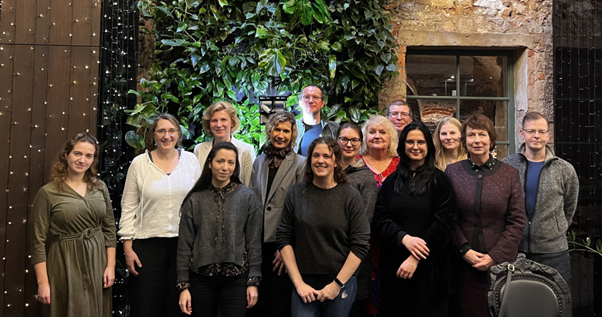It is well known that regular physical exercise reduces the risk of various cancers, including breast cancer as well as helps mitigate fatigue, treatment side effects and recurrence, and improves the quality of life of cancer patients post-diagnosis. Now we better understand – how.
The main goal of the Baltic Research Programme’s project “Exploring the molecular mechanisms behind the effects of physical exercise on breast cancer prevention” (CancerBeat) was to gain a deeper understanding of the molecular mechanisms behind the beneficial effects of exercise on preventing the progression of breast cancer.
We recruited two groups of study subjects – breast cancer patients, who were randomized into high-intensity interval training and standard-of-care control groups, and healthy endurance runners, who served as a reference. The training group took aerobic exercise sessions for the whole duration of neoadjuvant chemotherapy, while the control group was advised to keep their usual level of physical activity. Pre and post-exercise blood samples were collected from all participants, and tumour tissue specimens were collected from breast cancer patients after surgery. The clinical samples were exploited for various molecular analyses. To gain a deeper understanding of the effects of exercise on tumour microenvironment and metastasis, murine breast cancer models were used.We found that regular exercise significantly improved response to chemotherapy, helped to maintain a higher quality of life, reduced cancer symptoms and mitigated treatment side effects. RNA sequencing analysis of tumour and normal breast tissues revealed exercise-induced alterations in the tumour-intrinsic gene expression profile and showed that exercise alters the composition of tumour-infiltrating immune cells. We further focused on the role of extracellular vesicles (EVs) in mediating the beneficial effects of exercise. During exercise, EVs are released into the circulation and mediate tissue crosstalk with potential effects on tumour cells and the immune tumour microenvironment. Analysis of exercise-induced EV cargo revealed several miRNAs, mRNAs and proteins that were upregulated during exercise and reflected various physiological processes going on in the body during exercise. However, the effects of exercise-induced EVs on the proliferation, metabolic activity and gene expression profile of BC cells were highly variable among the individuals and cell lines. In mice models of BC, treatment with exercise-induced EVs reduced tumour growth by 19-57% and triggered a proinflammatory antitumor immune response, converting immunologically “cold” to “hot” tumours.
In conclusion, this project demonstrated that HIIT significantly improves response to chemotherapy and quality of life in BC patients thus supporting the incorporation of physical activities in the treatment plans of BC patients and prompting the initiation of a clinical trial investigating the effects of HIIT and/or exercise-induced EVs on the efficacy of immunotherapy.
The results of this project were disseminated via 8 scientific publications in highly ranked journals and presented at 12 international scientific conferences and served as a basis for 2 EU and 2 national grant applications.
CancerBeat was a truly interdisciplinary project combining a wide spectrum of scientific fields – oncology, molecular and cellular biology, tumour immunology, bioinformatics, biomarker discovery, sports medicine, exercise physiology, physiotherapy and bioenergetics. The project included five teams from 4 countries with complementary experience in these topics. Two face-to-face and several online meetings took place during the project allowing researchers to interact and exchange ideas.
Collaboration was fruitful and mutually beneficial for all project partners:
Prof. Alicia Llorente, OUH, Norway: “It was a pleasure to participate in this project and to collaborate with excellent groups from the three Baltic countries. The coordination and communication among the groups worked perfectly and the synergies established helped us to achieve considerably more and better results than if we had worked separately. The complementarity between the groups was very good and the exchange of knowledge was very beneficial for my group.”
Prof. Tuuli Käämbre, NICPB, Estonia: “Participating in this multidisciplinary and patient-oriented project was an opportunity for our research team to contribute to a rapidly developing and new perspective-opening field, such as intercellular communication through extracellular vesicles. We are excited about further developments in this field, as our results demonstrated a direct effect of exercise-induced extracellular vesicles on the bioenergetics of cancer cells in vitro.”
Dr. Rūdolfs Cešeiko: “Our research team is encouraged by the promising results of our multidisciplinary study on exercise training for breast cancer patients, demonstrating significant improvements in physical capacities and quality of life. We are excited to contribute to the growing body of evidence that further supports the health and well-being of individuals undergoing cancer treatment.”
Dr. Agata Mlynska: “Participating in the CancerBeat study was a mutually rewarding experience that led to new findings in the preclinical setting, which we believe could be further translated to clinical applications. The project also allowed us to learn and connect with professionals from various fields, enhancing our collective expertise.”
The results of this project provided mechanism-based evidence and consolidated the concept that regular physical exercise should be included as an integral part of supportive care for breast cancer patients undergoing chemotherapy. Communication with healthcare specialists, patient associations and general public was an important part of the project. These activities raised awareness of the beneficial effects of physical activities in cancer patients, helped the patients to get out of their sick mood, and gave motivation to the patients to incorporate regular physical activities into their daily routine.
Participant of the CancerBeat study: “Well-organized training during the cancer treatment process was an invaluable component. It enhanced physical and mental well-being and helped maintain strength and endurance, which was crucial for coping with the treatment side effects. Regular exercise reduced fatigue and improved energy levels. Physical training during the process of cancer treatment was empowering and allowed me to take an active role in the treatment instead of just passively following the medical treatment plan. Overall, such a training approach improves holistic healing and helps to improve both the physical and mental health of the patient.
Photo: Latvian Biomedical Research and Study Centre
